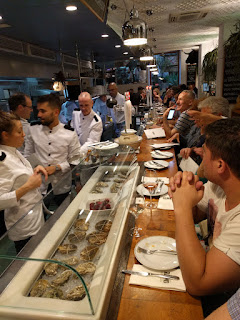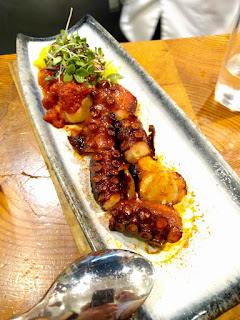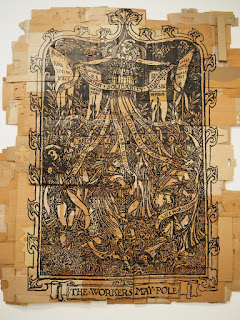...past the glorious cathedral, of course...
...then headed to dinner at the really fun Bar Cañete (warning: a little salty language on their website), which was full of both all manner of people (locals and tourist alike) and all manner of excellent food. We tried out their bomba, razor clams, white beans with squid, pork belly with mashed potatoes, and fried bread pudding with ice cream. (I've just now come to the decision that white beans and squid are, thus far, my favorite thing to eat in Barcelona. So good, everywhere we've tried them.)
The view from our seats at Bar Cañete. Very busy.
The next day, we set out for El Born and its Cultural Center, by way of Santa Maria del Mar. (Please pardon any and all blurry photos; I was still working with my sad, broken, no-stabilization Sony.)
Passed the remnants of the 15th-century convent of Sant Agusti, now a cultural center offering workshops and concerts.
El Born Cultural Center, which occupies the former El Born Market, opened as the city's first cast-iron building in 1876, and in use as a market until 1971.
Inside, there's a bit of a surprise: the entire center of the floor plan has been excavated down to the 17th- and18th-century streets beneath.
This channel was once a canal drawing water from the river Besos, and was probably built in the 10th century--and was in use, like the market, until the 1970s.
Here, Viola Corders' Street, so named due to (you probably guessed this) the presence of many makers of stringed instruments in this neighborhood in the 17th and 18th centuries.
The Cultural Center has a massive and amazing display of the ceramics and household items found during excavation.
Like, for example, this gorgeous, intricately-painted plate...
...or this one with an insane chicken on it.
Back outside, we went to check out Santa Maria del Mar, an incredible Gothic church which we hadn't had time yet to visit properly. The single most striking thing about this place is how much bigger it seems on the inside than on the out. (FYI, the name comes from the fact that this church used to be much closer to the actual seashore than it is now. And also, it's near-impossible to get a photo of the entire front, given the rather tiny nature of the plaza in front of it. The church has a huge footprint, but there's very little space around it.)
The cornerstone of this church was laid in 1329, according to this inscription. (Rather notably, in the grand scheme of Gothic church-building, they finished this thing in record time; it was consecrated in 1384.)
The inside is absolutely magnificent.
All manner of interesting gravestones in the floor, but in particular, lots of skulls...
...and this single one with a ship! Neat.
Unbelievably tall columns in the ambulatory.
Strange little animals on these small decorative column capitals outside.
And speaking of ships: around the corner from Santa Maria, on our way to the excellent Casa Gispert, we spotted this on the side of an apartment building. Very cool.
Next, we made our way through the city (dragon and umbrella on the Placa de la Boqueria, because why not??)...
...to lunch at Bar Cañete. Which felt ridiculous, repeating ourselves like that, but our plan had been to get lunch at La Boqueria, and since we couldn't find space anywhere there and then I got pooped on by a bird, we decided to cut our losses and head to a place with an actual indoor bathroom where I could try to tidy up. One which was nearby and had guaranteed-good food. It was very convenient. Round two included pimientos de padron, chicharrones, octopus with potatoes and spicy tomato sauce, a small cheese plate, and, of course, my squid 'n white beans.
Octopus!!!
Squid and beans: get in my mouth.
Our next destination was also right 'round the corner: Palau Guell (built between 1886 and 1890), the last major Gaudi building in the city that we hadn't seen yet. Another weirdish creation by the master of bizarro-Modernismo, although he hadn't quite hit his full crazy-pants stride here just yet. (Park Guell came along in 1900; Casa Batllo between 1904 and 1906; and La Pedrera between 1906 and 1912.) (And don't let my name-calling fool you: I love Gaudi's stuff. It's so outlandish and impossible.)
Parabolic arches and iron sculpture on the main facade.
Rather poor shot of the underground stables.
Super fancy peephole in one of the offices.
Cast-iron column in the billiard room.
Amazing woodwork in the visitors' room...
...along with a bejeweled ceiling.
The stunning central hall.
Marble Modernismo medallion in the upstairs Hall of Intimates.
Craziness on the rooftop. This is the 15-m-tall central spire, which crowns the central hall...
...and is surrounded by 20 of these crushed-tile and -stone chimneys.
It's a riot of weirdness.
Green!
Even the weathervane is offbeat.
You can just barely see some of the chimneys from the street below.
Dinner that night was at one of our favorite restaurants in the world, Niño Viejo. Yes, I fully realize that it seems a bit ridiculous to eat Mexican food in Spain, but A) upscale Mexican food is quite popular and prevalent there right now, and B) the food at Niño Viejo is off-the-chain fantastic. (Plus, instead of rimming their margaritas with salt, they put salt foam on top. What's not to love??) We shared a helping of guacamole and homemade chips; a wee tostada with tuna, spicy red sauce, coriander, and avocado mayo, and one with octopus ceviche with green salsa, coriander, and avocado mayo; tacos al pastor; salsa verde chicken enchiladas with black beans and queso fresco; "divorced eggs"...
...sunny-side-up eggs in red and green salsas with black beans, queso fresco, radishes, onions, and coriander...
...one each of salsa verde chicken and barbacoa flautas; one each of fish and al pastor tacos (yes, more al pastor); and for dessert, corn flan for Mike and a tamarind popsicle for me. Tremendous, tremendous food (and the portions are rather small, so while we did, in fact, eat a lot of food, it's not nearly as much as it sounds).
And we had the best seats in the house, at the bar, where you can watch all the action in the kitchen. It's so fun to watch these guys work--their precision and artistry is a wonder to behold--and occasionally you get to chat with them, which is fantastic. (And if you're Mike, they give you a ton of extra salsa.)
The next morning, Mike headed out early to the airport, and I drank a nice coffee in a shady little plaza near our hotel, then took an inordinate number of photos of the Modernismo buildings in our neighborhood, and then headed back to Zürich myself. But first...
So many, and so pretty.
And because I have lots of blog-related tidying-up to accomplish here, I'm going to squeeze in both another Mike-flies-somewhere trip and a couple of concerts. Here we go.
In early July, I flew to London to rendezvous with Mike as he was on his way back from the US so that we could see U2 perform The Joshua Tree album in its entirety. I'm not really one for stadium concerts--I much prefer far smaller venues--but this was one we just couldn't let pass us by. First, however, we had some eating and museum-seeing to do.
First stop, the Tate Modern, which neither of us had seen in years and years.
The building itself, a former power station, is awesome, in the most literal sense of the word. (There's a guy on the lower left here for scale.)
Also, it's a bit disconcerting to walk into what is ostensibly a free museum (no entrance charge, only donations, unless you want to go to the special exhibits!) and have basically the first thing you see be a Mondrian, just right there.
So, the Tate is massive. Übermassive. There's some stuff there that's a bit weird/off-putting for me (as we all know, Art Nouveau is my jam, and this ain't that), but there were plenty of really interesting, lovely, powerful, and/or thought-provoking things in there as well. For example, Andrea Bowers' The Workers' Maypole, an updated version of an Industrial-Revolution-era illustration from a socialist magazine. It's permanent marker on cardboard, and it's amazing.
Mike and I both liked this one, although it's a bit eye-disturbey: Gerhard Richter, a German artist, digitally split a photo of his own painting about a jillion times, then reassembled it, to create a thought-piece on the role of artist in the modern age of technology (i.e., is there one?).
Because it contains artwork post-1900, the Tate has a few more traditional pieces, as well, including this massive Monet from 1916.
Also liked Louise Nevelson's An American Tribute to the British People, a found-object assemblage made mostly of furniture offcuts and scrap wood, with an incredibly cathedral-altar-like feel to it.
A little Warhol for ya. (There were some Marilyns, too.)
For no reason I can fathom, I dearly loved this giant pink glass cube. Pink Tons is supposed to be all about the way natural light interacts with this physically solid object to create an ambiguous sense of its mass, but I just really like that it's a huge pink glass cube. I would gladly have this in my house. ("Oh, that? That's the cube." End of story.)
This was my favorite piece in the whole museum: The Forty Part Motet, by Janet Cardiff, who recorded 40 members of the Salisbury Cathedral Choir individually singing a single part of the Renaissance piece 'Spem in Alium.' There are 40 speakers in this circle, each one playing a single singer's part, and if you sit in the middle, the entire choral piece washes over you, but if you stand at any speaker in particular, you can hear the individual voice. It's gorgeous.
Dinner after the Tate was at our new London go-to, the Clove Club, where they treated me like a queen. (I've been having some health issues which have drastically affected my diet as of late, and the Clove Club was more than kind and gracious about making delicious food for me that I could actually eat. It was amazing and awesome and I couldn't be more grateful.)
This, people, is what the best fried chicken in the world looks like. The only down side is that you each get one single niblet, and that's it.
I won't rattle off the whole long menu, but I will say that these pastry-baked potatoes with a sorrel sauce including dehydrated wakame, crispy buckwheat, and sea asparagus almost made me cry, they were so good. (Sorrel? Never had it before. Holy wow, is it delicious.)
The next day, after a quick dash through The Liberty...
Ugh, coolest department store ever, and all decked out for Pride.
This thing was built in 1924 from the timbers of the HMS Impregnable and HMS Hindustan.
I need these chairs in my home and in my life.
...alongside part of the Pride parade route, where I desperately wanted to stop and watch for a bit, but it was just too insane:
I read somewhere there were 26,000 people marching in the parade and a million watching. I'd buy that.
...then off to a quick dinner with some friends who live in Twickenham (which is terribly adorable, by the way), and then to the main attraction: U2. The Joshua Tree. We were there, and I still can't even deal with it. For lack of better words to express the experience--yes, I know how laden The Joshua Tree is with actual religious imagery, and so just how on-the-nose this is--but hearing these songs in person was a near-religious experience. Powerful. And for that reason, I present to you a good 8-10 minutes of raw concert footage. Watch if you want, but no feelings will be hurt if you don't.
Doesn't your heart just race when you hear those opening chords?? (Sorry 'bout these videos. Any and all lens flare is on the part of my terrible, terrible phone camera.)
Ok, and these chords, too...
And this was a nifty surprise: they set a slideshow of influential/famous/amazing/accomplished women to "Ultraviolet." (Not one of my most favorite songs of theirs, but Achtung Baby was the soundtrack to my freshman year of high school, so it was fun to hear something from that album. Another delightful surprise was "Beautiful Day" from All That You Can't Leave Behind. That song was my theme song, if you will, during the 3 weeks I spent backpacking around Europe by myself in 2000. [It was my "get courageous!" and/or "today will be amazing..." song.])*
And we weren't done with music that week, oh no. Back in Zürich, we managed to catch Rodrigo y Gabriela at the Volkshaus (much more my style), and I can say with certainty that we will always make sure to go to their shows when they're in town. What a phenomenal duo with an unbelievable amount of talent, and boy, can they put on a live show. (Even when poor Gab is in a wheelchair after a jogging mishap.)
A good example of the crazy kind of energy they have on stage. (All flamenco-sounding percussion is her, drumming on her guitar body as she plays.)
Maybe they'd done this before and I just didn't remember, but this time they had cameras at guitar-level so you could see the insane maneuverings of their fingers. Unreal.
Two days later, there came Sir Elton, who plays the heck out of that piano. He's extraordinary.
Between each song he'd get up and point at the crowd in several directions. It was tremendously campy and I loved every second of it. (Apologies for the horrendous nature of this photo; see above for an account of how my phone camera is crap.)
We could have fit in a Flogging Molly show that week, as well, but we were feeling a bit lazy and didn't...and now we both regret it. Would have been the Best. Week. in Music. Ever.
And with that, things settled down for litrally a day or two, after which we packed everything up and headed for southern Italy. That's up next.
*I am just now realizing how many formative years and experiences involved music from this band. No wonder I wanted to go so badly...



























































No comments:
Post a Comment
Note: Only a member of this blog may post a comment.